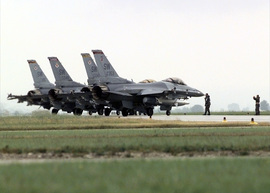By the end of 1998 more than 300,000 Kosovars had already fled their homes, the various cease-fire agreements were systematically being flouted and negotiations were stalled.
Two rounds of internationally brokered talks in Rambouillet, France, in February and in Paris in March 1999 failed to break the deadlock and exhausted diplomatic avenues. At the time, autonomy for Kosovo within the Federal Republic of Yugoslavia, guaranteed by the presence of a NATO-led force, could have been assured. Accepted by the Albanian delegation, the proposal was rejected by Belgrade.
NATO announced the suspension of the air campaign on 10 June, once it had concluded a Military Technical Agreement with the Federal Republic of Yugoslavia. The same day, UNSCR 1244 welcomed the Federal Republic of Yugoslavia’s acceptance of the principles for a political solution, including an immediate end to violence and a rapid withdrawal of its military, police and paramilitary forces and the deployment of an effective international civil and security presence, with substantial NATO participation.
The political objectives of the air campaign
They were to bring about:
- a verifiable stop to all military action, violence and repression;
- the withdrawal from Kosovo of military personnel, police and paramilitary forces;
- the stationing in Kosovo of an international military presence;
- the unconditional and safe return of all refugees and displaced persons and unhindered access to them by humanitarian aid organizations;
- the establishment of a political agreement for Kosovo in conformity with international law and the Charter of the United Nations.
The campaign proper
Despite strains, the Alliance held together during 78 days of air strikes in which more than 38,000 sorties – 10,484 of them strike sorties – were flown without a single Allied fatality.
After first targeting the Federal Republic of Yugoslavia’s air defences, NATO gradually escalated the campaign using the most advanced, precision-guided systems and avoiding civilian casualties to the greatest extent possible.
Target selection was reviewed at multiple levels of command to ensure that it complied with international law, was militarily justified, and minimized the risk to civilian lives and property.
Having intervened in Kosovo to protect ethnic Albanians from ethnic cleansing, NATO has been equally committed to protecting the province’s ethnic Serbs from a similar fate since the deployment of KFOR in the province in June 1999.
The build-up to the air campaign and its immediate aftermath
Simmering tension in Kosovo resulting from the 1989 imposition of direct rule from Belgrade of this predominantly Albanian province erupted in violence between Serbian military and police and Kosovar Albanians at the end of February 1998.
The international community intervenes
The international community became increasingly concerned about the escalating conflict, its humanitarian consequences and the risk of it spreading to other countries, as well as Yugoslav President Slobodan Milosevic’s disregard for diplomatic efforts aimed at peacefully resolving the crisis and the destabilizing role of Kosovar Albanian militants.
On 13 October 1998, the North Atlantic Council authorized activation orders for NATO air strikes, in support of diplomatic efforts to make the Milosevic regime withdraw forces from Kosovo, cooperate in bringing an end to the violence and facilitate the return of refugees to their homes. Following further diplomatic initiatives, President Milosevic agreed to comply and the air strikes were called off.
The Kosovo Verification Mission
Further measures were taken in support of UN Security Council resolutions calling for an end to the conflict, including the establishment of a Kosovo Verification Mission by the Organization for Security and Co-operation in Europe and an aerial surveillance mission by NATO, as well as a NATO military task force to assist in the evacuation of members of the Verification Mission in the event of further conflict.
The crisis intensifies
The situation in Kosovo flared up again at the beginning of 1999, following a number of acts of provocation on both sides and the use of excessive force by the Serbian military and police. This included the massacre of 40 unarmed civilians in the village of Racak on 15 January.
Renewed international efforts to give new political impetus to finding a peaceful solution to the conflict resulted in the convening of negotiations between the parties to the conflict in London and Paris under international mediation. These negotiations failed, however, and in March 1999, Serbian military and police forces stepped up the intensity of their operations, moving extra troops and tanks into the region, in a clear breach of agreements reached.
Tens of thousands of people began to flee their homes in the face of this systematic offensive. A final unsuccessful attempt was made by US Ambassador Richard Holbrooke to persuade President Milosevic to reverse his policies. All diplomatic avenues having been exhausted, NATO launched an air campaign against the Milosevic regime on 24 March 1999.
The aftermath of the air campaign
Following diplomatic efforts by Russia and the European Union on 3 June, a Military Technical Agreement was concluded between NATO and the Federal Republic of Yugoslavia on 9 June. On the following day, after confirmation that the withdrawal of Yugoslav forces from Kosovo had begun, NATO announced the suspension of the air campaign.
On 10 June, UNSCR 1244 welcomed the Federal Republic of Yugoslavia’s acceptance of the principles for a political solution, including an immediate end to violence and a rapid withdrawal of its military, police and paramilitary forces and the deployment of an effective international civil and security presence, with substantial NATO participation.

